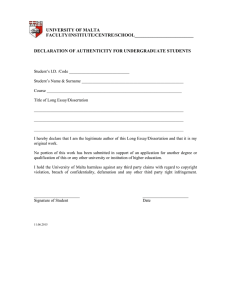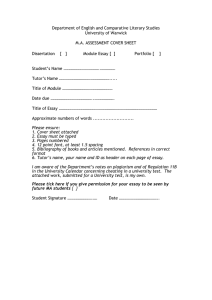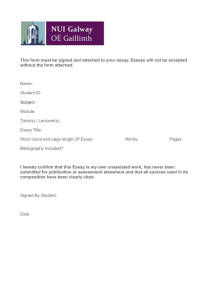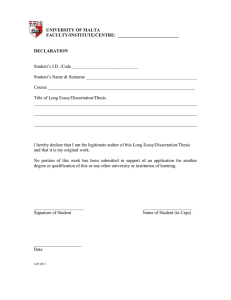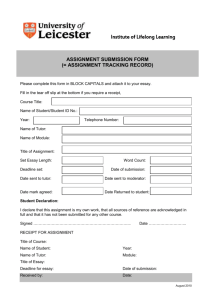B.A. (Hons.) Tourism Studies - Long Essay Guidelines
advertisement
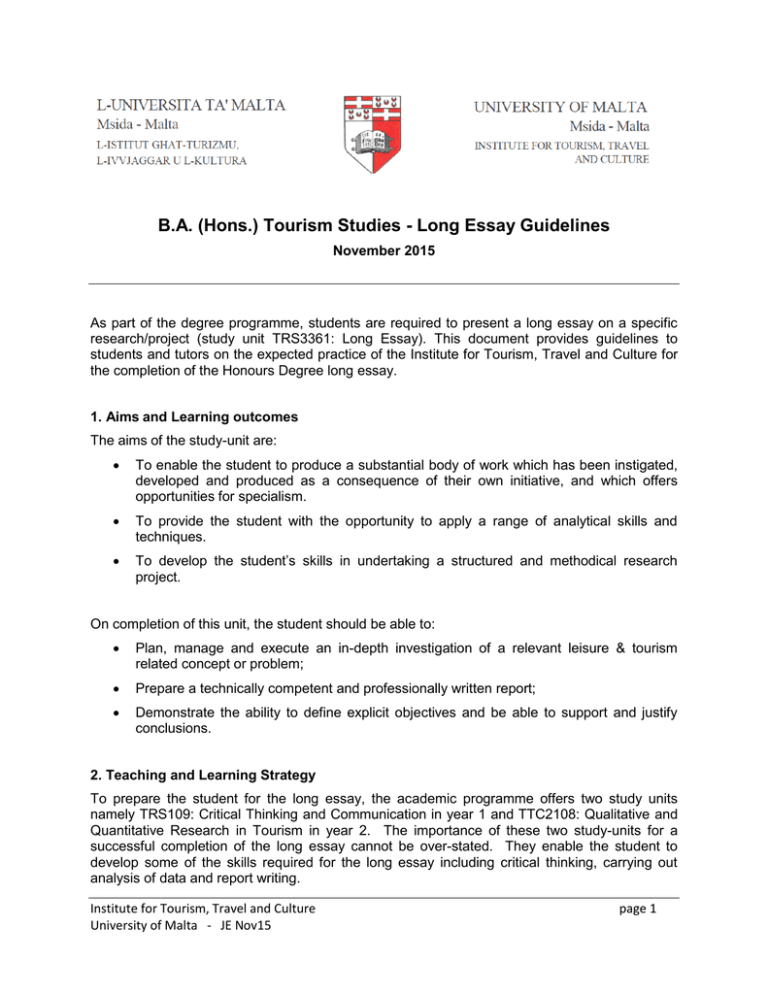
B.A. (Hons.) Tourism Studies - Long Essay Guidelines November 2015 As part of the degree programme, students are required to present a long essay on a specific research/project (study unit TRS3361: Long Essay). This document provides guidelines to students and tutors on the expected practice of the Institute for Tourism, Travel and Culture for the completion of the Honours Degree long essay. 1. Aims and Learning outcomes The aims of the study-unit are: To enable the student to produce a substantial body of work which has been instigated, developed and produced as a consequence of their own initiative, and which offers opportunities for specialism. To provide the student with the opportunity to apply a range of analytical skills and techniques. To develop the student’s skills in undertaking a structured and methodical research project. On completion of this unit, the student should be able to: Plan, manage and execute an in-depth investigation of a relevant leisure & tourism related concept or problem; Prepare a technically competent and professionally written report; Demonstrate the ability to define explicit objectives and be able to support and justify conclusions. 2. Teaching and Learning Strategy To prepare the student for the long essay, the academic programme offers two study units namely TRS109: Critical Thinking and Communication in year 1 and TTC2108: Qualitative and Quantitative Research in Tourism in year 2. The importance of these two study-units for a successful completion of the long essay cannot be over-stated. They enable the student to develop some of the skills required for the long essay including critical thinking, carrying out analysis of data and report writing. Institute for Tourism, Travel and Culture University of Malta - JE Nov15 page 1 For the assignment of second year’s TTC2108 – ‘Qualitative and Quantitative Research in Tourism’ each student is required to prepare a proposal for the long essay. This proposal is the basis for the long essay which the student will work on in the third year. At the end of the second year, in July, the ITTC Board of Studies confirms the title of the long essay and assigns a tutor to each student. In most cases, the tutor will be a member of ITTC’s academic staff. It is advisable that for the subject of the long essay, the student selects an area of study in which he/she already has an interest in. Interest in the subject, coupled with a keen sense of curiosity, will make the student’s long essay work less challenging. If the student is unable to think of a subject, the ITTC will suggest titles for the student to choose from. The ITTC sometimes refers to stakeholders to identify possible essay titles thus making the essay useful also for the industry. Apart from the tutor, the ITTC has appointed a long essay coordinator. The coordinator is a point of reference for the student and for the academic tutor should any guidance be required. The ITTC Research Coordinator for 2015/2016 is Prof. Andrew Jones. 3. Planning your work The long essay is the work of the student and it is your responsibility to take all the relevant decisions on how to plan the work and on how the research is to be carried out. The role of the tutor is to advise and to provide guidance. It is also the student’s responsibility to ensure that work on the long essay progresses well throughout the third year, to enable submission according to the deadline and without a last minute rush. The dissertation is a deceptive experience. The submission deadline seems far away when you start so there is the danger of time-wasting in the early stages of the process. Start writing as soon as is practicable. There are dangers in putting off this task. Always allow as much time as possible for the final stages. Final amendments, organising typing/word processing and doing a thorough job on the proof reading all take longer than you imagine. Something will always go wrong to thwart your schedule! It is recommended that the student initiates work on the literature review during the summer months prior to the start of the third year. Prior to this, an initial meeting between student and tutor is recommended. 4. Meetings with tutor Students are expected to meet their tutor on a regular basis. The frequency of meetings depends on the specific circumstances of the research carried out by the student and the level of guidance that would be required. As an indication, a meeting with the tutor on average once every three weeks should suffice but more frequent meetings may be required. It is the student’s responsibility to request a meeting with the tutor (normally by means of email). The tutor will propose a date and time convenient to both. Students are reminded to check their UoM email address regularly because, like most other study-units, this is the email address which the tutor is likely to use to communicate with the student. Meetings are usually to be held in the ITTC boardroom or in the office of the tutor. Institute for Tourism, Travel and Culture University of Malta - JE Nov15 page 2 There may be circumstances where it is not possible to keep to regular meetings. This is not desirable, but if unavoidable, it is considered mandatory for the student to meet the tutor very early on in the work phase. This meeting is essential to ensure that the student is on the right track in terms of research subject, methodology and programme of work. It is also mandatory for the student to meet the tutor before final submission. The tutor will need to see the work of the student and advise the student whether it is of an adequate standard to be submitted. This meeting should be held two or three weeks before the deadline for submission. The student should take notes of the discussion with the tutor. The advice and guidance given by the tutor is essential for the student’s learning process and failure to take notes may mean that an important piece of advice is lost. Taking proper notes enables the student to make the best of the time spent discussing with the tutor. The student may have to update the notes after the meeting and ensure that they are complete. The tutor should encourage the student to take notes and also allow him or her time to take down notes without undue difficulty. Moreover, the tutor should keep a log of meetings (and emails if any) and include date and brief note of the advice given. 5. Word length It is recommended that the length of the long essay will not exceed 10,000 words. Note that an important criteria in the assessment of the long essay is the clarity and precision in the writing up. A long essay that exceeds the 10,000 word limit will be penalised if it includes text which does not add value to the subject matter. In other words, a long essay which includes chunks of text which are long-winded or repetitive is likely to be penalised. 6. Submission A date will be set for final submission. This would normally be in the second week of May. It is recommended that the student completes a draft of the dissertation by mid-April and submits to the tutor for his or her final comments. Before mid-April subject to the agreement of the tutor, it may be possible for the student to submit chapters of the long essay to the tutor for comment. On or before the deadline, the student is to submit two spiral bound copies and an electronic copy of his/her long essay to the ITTC administration office. (For information on electronic dissertations refer to http://www.um.edu.mt/library/dissertations.) After the result of the long essay is issued, the student is to hand in one hardbound copy to the ITTC administration office. The hardbound copy should have a black cover with silver lettering. In exceptional circumstances, a student may be given an extension beyond the deadline. A student requesting an extension must do so in writing to the Research Coordinator justifying the request and explaining the mitigating circumstances. The request is to be made in advance of the submission date. A request for extension will only be granted if the research coordinator and the tutor are satisfied that the student committed time and effort to the long essay throughout the year. Upon completion of the examination process electronic copies of the long essays are then compiled on a CD and forwarded to the library to be placed online. Institute for Tourism, Travel and Culture University of Malta - JE Nov15 page 3 7. Assessment Criteria The criteria for assessment will be as follows: Selectivity, clarity and relevance of literature review; Quality and innovation of ideas and precision of research objectives; Appropriateness of research design and skill in execution of research; Fullness and appropriateness of description and analysis of data; Clarity and precision in the writing up of the report and conclusions drawn; The assessment of the long essay, therefore, will be based upon a clear expression and articulation by the student of an analytical approach, research focus, clear methodology and stated results of a research project. It is important that you read the appendices carefully, including Appendix E which is specifically on assessment criteria. Note that as well as the criteria listed, the overall grade will take into account the coherence of the document and legitimate constraints imposed on the study. The long essay will be assessed by a member of the ITTC’s academic staff who will also consult with the student’s tutor. All long essays will be made available to the External Examiners. In cases where students have deemed to fail or there is a discrepancy in marking, a third examiner will be appointed and the external examiner consulted. Students may also be requested to attend a viva voce examination. This would be in the first or second week of July. 8. Plagiarism and other forms of academic dishonesty Plagiarism, that is, the wilful representation of another person’s work, without the acknowledgement of the sources, as one’s own or the deliberate and unacknowledged incorporation in a student’s work of material derived from the work (published or otherwise) of another, is UNACCEPTABLE. Such practice will incur the penalty of outright failure. A selection of long essays will required to be submitted through the UoM VLE for Turnitin evaluation. The tutor will set up Turnitin Assignment activities (Draft & Final) in the relevant UoM VLE areas, for the student to submit the work. Turnitin compares work against electronic sources including the internet, books, journals and other students' work, and generates an originality report indicating which parts of the work are unoriginal. The student is allowed to submit a draft version of the work and view the Turnitin originality reports for this, before submitting the final version for Turnitin assessment. (More information on plagiarism and the use of Turnitin is available at http://www.um.edu.mt/vle/pds/students/faqs#q2.) Not all students will be requested to submit their long essay for Turnitin assessment. The choice of long essays to be submitted to Turnitin will be made at random except that the Research Coordinator, in consultation with the respective tutor, may select other students for the Turnitin submission of their work. Failure to comply and submit to Turnitin, if requested to do so, will result in a significant reduction of marks in the examination of the long essay. Apart from plagiarism, other forms of academic dishonesty will not be tolerated. These include commissioning (presenting the work of others as one’s own), false declaration (making a false declaration in order to receive special consideration or to obtain extensions to deadlines) and falsification of data (presentation of data based on work purported to have been carried out by the student, which have been invented, altered or copied by the student). Institute for Tourism, Travel and Culture page 4 University of Malta - JE Nov15 9. Research ethics The University Senate set up a Research Ethics Committee (REC) which drew up a set of guidelines to govern research within the University of Malta. The guidelines envisage a simple structure that can safeguard both ethical standards and efficiency while ensuring proper accountability. The student’s research requires the endorsement of the Research Ethics Committee if: (1) The research involves vulnerable persons, like for example children (under the age of 18), mentally disabled persons or economically or educationally disadvantaged persons. (2) The research includes questions that some people may consider to be sensitive (race or ethnic origin, political opinions, religious or philosophical beliefs, trade union memberships, health, sex life, genetic information). Endorsement is not required if either (1) or (2) are not applicable. If in doubt, consult your tutor or Ms. Marie Avellino who is the Chairperson of the ITTC’s Research Ethics Committee. If endorsement is required, the student is to fill in and submit the proposal form ‘Request for Approval of Human Subjects Research’ to ITTC Office. (For more information on research ethics and for the proposal form refer to http://www.um.edu.mt/urec.) You are to note that the process of application through to acceptance can take up to 6 weeks or more, so as to ensure that the Research Ethics application is submitted in time to enable you to carry out your human research. 10. Conclusion Students are encouraged to take a positive approach to the long essay. This is an opportunity to do your own piece of work and also to satisfy your curiosity on a particular area of knowledge. Above all, it is a learning experience which will help you for your future career as you develop your critical and analytic skills and your report-writing skills. It is up to the student to make the best of it. Some students are tempted to take short cuts and even resort to academic dishonesty (see relevant section above) but failure to make the best of this learning experience will be your loss. It is for the student to make the best of this learning experience Institute for Tourism, Travel and Culture University of Malta - JE Nov15 page 5 List of Appendices Appendix A: Format and Structure of the Long Essay Appendix B: Do’s and Don’ts in the Literature Review Appendix C: Writing and grammatical conventions Appendix D: Referencing and Citations Appendix E: Assessment Criteria Institute for Tourism, Travel and Culture University of Malta - JE Nov15 page 6 Appendix A: Format and Structure of the Long Essay What follows are guidelines and some helpful advice on acceptable practice. Since the nature of dissertations/long essays may vary, you are advised to consult your tutor for more specific advice in relation to your long essay. Title Page Authenticity Form It is important to submit your Authenticity Form with your Long Essay. The Authenticity Form must be signed, scanned and inserted in the introductory pages of the electronic and hard copy of your long essay. The Authenticity Form can be obtained from www.um.edu.mt/ittc/dissertations. The Abstract An abstract should provide an overview of your study in all its aspects. It should be around 250300 in words and should answer the following questions. What does this research set out to do and why? How did it seek to do it? What are the general findings? What do these suggest? What conclusions are reached? What are the implications of these? Acknowledgements In this section you should express thanks to those who assisted you in your research. These should be kept to a minimum and include only academic supervisors and people who participated in the fieldwork; most people like to thank family too. Table of Contents Introduction In the introduction you should introduce the reader to the background of the study and the nature of the problem being considered. It should therefore set the study in context, explaining why this study is important, highlighting significant issues, problems and ideas. The aim and objectives should be stated clearly in this chapter. Institute for Tourism, Travel and Culture University of Malta - JE Nov15 page 7 Literature Review In a dissertation/long essay, a student is expected to provide a critical review of the existing literature on the research topic being studied. The purpose of the review is to bring together relevant knowledge and information on the selected topic. It should act as the basis for the eventual analysis in the long essay where the outcome of the student’s research is discussed in the context of existing knowledge. The literature review should be the point of reference in the discussion on the research question. Avoid using material in the literature review which is not relevant to the subject at hand. A frequent mistake made by students is to give a lot of generic information on the tourism situation in Malta when the subject of the long essay is about one particular aspect of Malta’s tourism. Moreover, the material used for the literature review should be academic journal and academic books. Reference to newspapers may be required sometimes but this should be done only occasionally. The same is applicable to non-academic internet sources. Methodology The purpose of this chapter is to indicate what you actually did in your research so that your reader may evaluate the design, procedure and findings of your study. The purpose of the Methods chapter is to give a well-documented outline of the methods used so that any other researcher can replicate the research and test it for viability. Students need to be aware of the significance of this point. The method section should be well-structured, written in a concise, matter-of-fact manner and should provide answers to the following questions - What actually happened - How? - To whomWith what result? - How were problems dealt with? Approach to data? The following is an outline of the Methodology Section : Review of Data Collection Methods (an in-depth discussion on the chosen methodology relevant to your area of research and a discussion why other methodologies were refuted /not applicable to your research). Secondary Data (analysis of the supporting data to be used in research such as published studies etc.) Primary Data (where an in-depth description is given of the tools - such as fieldwork, document analysis, surveys carried out, when it was conducted, duration) Criteria for Sample Selection (detailed description of how the sample for your study was chosen - this applies for both qualitative as well as quantitative research) Pilot Study: prior to actually collecting the data on which you are going to base your research, you need to test the tool for clarity, use of terminology. This is the pilot study - any changes conducted to the original tool need to be documented. Methods of Analysis (discussion of the methods of analysis used, such as SPSS, content analysis, deconstruction, textual analysis, semiotics, historical analysis, etc) Limitations (of the methods used, for example access to informants). You should also show how you have tried to overcome such limitations. Institute for Tourism, Travel and Culture University of Malta - JE Nov15 page 8 Analysis and Results The findings are analysed and the results are presented and discussed with reference to theories and ideas outlined in the literature review. Discussion of Results, Conclusions and Recommendations This chapter should draw together all the issues of the research and link back to the aims and objectives which were outlined in the Introduction. Have the aims set at the beginning been met? If not, why not? What are the implications arising from the findings? Be careful with your generalisations and your interpretations. ALL recommendations should be based on evidence. Do you have suggestions for future research in this area? References Full details of all the books and journal articles cited or referenced throughout the dissertation/long essay should be included in this chapter. Anything that you include in the dissertation that is not referenced will be assumed to be your own work. It is therefore essential to reference your work well and correctly. A reader should be able to identify the exact source and refer to it directly. The Harvard method of referencing is the recommended system. (Refer to Appendix D on how to reference correctly.) You should include references in order to: • acknowledge that the work/idea belongs to another person • provide evidence of your own research • illustrate a particular point • support an argument or theory • allow others to locate the resources you have used • avoid accusations of plagiarism Referencing is not about listing every book and article that has been written and/or that you have read about the subject. What is included in the reference list should be material that you have actually used in the literature review or elsewhere in the long essay. (More advanced research works may include a bibliography which includes material that is relevant to the subject at hand but which has not actually been cited in the literature review or elsewhere in the dissertation. In the long essay students are not required to include a bibliography). Appendices The Appendices should include selective, supplementary material which is distracting when placed in the main body of text. Only material which is necessary for a full understanding of your study should be included. These include important forms, questionnaires or interview schedules description of equipment or settings, tables and lists of data supportive of the study. It may also be useful to include a sample of the primary data collected for example the notes of interviews of the more important interviews. Institute for Tourism, Travel and Culture University of Malta - JE Nov15 page 9 NOTE: Keep all the primary data collected for example completed questionnaires, transcripts or notes of interviews etc., as the examiners may ask to see such evidence. Institute for Tourism, Travel and Culture University of Malta - JE Nov15 page 10 Appendix B: Do’s and Don’ts in the Literature Review 1. You should use the literature to explain your research. Your aim should be to show why your research needs to be carried out, how you came to choose certain methodologies or theories to work with, how your work adds to the research already carried out. 2. You need to summarize the work you read but you must also decide which ideas or information are important to your research, and which are less important and can be covered briefly or left out. You should also look for the major concepts, conclusions, theories, etc. that underlie the work, and look for similarities and differences with closely related work. 3. Your aim should be to evaluate and show relationships between the work already done (Is Researcher Y's theory more convincing than Researcher X's? Did Researcher X build on the work of Researcher Y?) and between this work and your own. In order to do this effectively you should carefully plan how you are going to organize your work. 4. As you will soon discover, if you try to be fully comprehensive you will never be able to finish the reading! The literature review should not provide a summary of all the published work that relates to your research, but survey of the most relevant and significant work. 5. It is easier to read than to write. However, writing can help you to understand and find relationships between the work you have read. Also, do not think of what you first write as being the final or near-final version. Writing is a way of thinking, so allow yourself to write as many drafts as you need, changing your ideas and information as you learn more about the context of your research problem and follow input and feedback from your tutor. 6. The moment will come when you have to write your references page … and then you realize you have forgotten to keep the information you need. To avoid this nightmare, always keep this information in your notes. Always put references into your writing. Institute for Tourism, Travel and Culture University of Malta - JE Nov15 page 11 Appendix C: Writing and grammatical conventions The typescript should be clear and consistent and typed in Font 12. The typing should be at least 1½ line spacing on A4 paper. Make sure your left-hand margin is sufficiently wide for binding purposes. Style: The literary style adopted must be suitable to your purposes. Avoid use of the first person. For example, "I investigated the following issues …", should be more properly phrased as "the following issues were investigated…" or "this study looked at…". Sentence Length: Ideally you should be concise and informative and you should aim to be clear. Clarity is often lost by using long sentences or inappropriate words. Overlong sentences tend to become very difficult for the reader to understand. Try to keep your sentences within reasonable length limits but, at the same time, use flexible and varied sentence lengths to prevent the style becoming stilted. Quotations should be typed in single inverted commas. If the quotation is more than four lines long it should be set as an extract and the whole quotation indented. N.B. The exact spelling and punctuation of the original should be followed. You should give the author's name, date and page number in brackets underneath. Abbreviations (and acronyms) must be typed in full when first mentioned, with the abbreviation in brackets. The abbreviation can be used thereafter. Numbers: Use words for numbers up to ten. Exceptions which should always be expressed as figures are: (i) ages (ii) percentages, e.g. 25 per cent. Non-sexist writing Use neutral terms, unless a specific male or female is meant. Page numbering: The entire work, including references and appendices, should be numbered consecutively from the first page of the first chapter. Page numbers should be located centrally at the bottom of the page. To note: Very good grammar and syntax is expected. It is recommended that dissertation is proofread. Tutors will NOT act as your proof readers. It is your responsibility to ensure that a good piece of work is presented to the Examiners’ Board. Always proof-read your copies for good grammar and presentation before handing your work to your tutor. Special attention should be given to the final version of your dissertation/long essay. Be prepared for the unexpected such as loss or corruption of files. Do regular back-ups of your work. An electronic version of your long essay will be kept online. The Library makes available edissertations to other University students. It is advisable therefore that the electronic version that you submit is user-friendly. A step-by-step guide on how to do this is available on the University website. http://www.um.edu.mt/library/helpandsupport/guidelines_for_electronic_dissertations Institute for Tourism, Travel and Culture University of Malta - JE Nov15 page 12 Appendix D: Referencing and Citations Referencing is what you do at the end of the dissertation where you list the sources you have used to complete your piece of work. This is called either a reference list or a bibliography and it is always written in alphabetical order by author name. Strictly speaking, a bibliography includes all sources you have used, whereas a reference list contains only sources that you have cited in your text. For the purpose of this dissertation/long essay, you are expected to include a Reference list. Citation is what you do in the actual text of your dissertation when you want to indicate the source you have used or from which you have quoted. The three most common sources of reference are books, journal articles, and internet documents, although by all means you are not precluded from using other sources such as the print media. Below are just a few examples based on the Harvard method of referencing: Books The basic pattern for a reference to a book is :Author, initials, (year), Title of book (Edition if later than first e.g. 3rd ed.). Place of publication: Publisher. Doganis, R. (2001). The airline business in the 21st century. London: Routledge. In the case of an Edited book use following format : Beech, J. & Chadwick, S. (Eds.). (2006). The Business of Tourism Management. Harlow, England: Prentice Hall. In the case of a Chapter in an edited book use following format : Zammit, J. (2008). From a National Airline to an EU Leisure-based Carrier. In A. Graham, A. Papatheodorou, & P. Forsyth (Eds.), Aviation and Tourism: Implications for Leisure Travel (pp. 119-135). Aldershot: Ashgate. Journal Article The basic pattern for a reference to a journal article is :Author, Initials. (year). Title of article. Title of journal, Volume number . For example: Buhalis, D. (2000), Marketing the competitive destination of the future. Tourism Management, Vol.21(1), pp.97-116. 28. Ideally, one should cite articles that are less than ten (10) years old. However, this is not cast in stone, and very much depends on the relevance and value of the academic article. Institute for Tourism, Travel and Culture University of Malta - JE Nov15 page 13 Electronic Sources (Internet) The basic pattern for a reference to an electronic source is : Author, Initials. (year). Title. Retrieved month day, year, from Internet address. Zalkin, C. (n.d.). Made in Japan: The Culture Behind the Brand. Retrieved August 29, 2009, from www.brandchannel.com. If no date is shown on the document, use n.d. . If the author is not given, begin your reference with the title of the document. Institute for Tourism, Travel and Culture University of Malta - JE Nov15 page 14 Appendix E: Assessment Criteria The assessment and weighting of each long essay will be based on the following criteria: i) Introduction- Rationale (5%) Grades will be awarded for: ii) Purpose of dissertation Underlying themes Assessment of practicability / feasibility / justification Choice of an unusual / new / challenging topic Key aims and objectives / hypothesis – proposed. Literature Review (25%) Grades will be awarded for: iii) Evaluation and review of both theoretical and secondary research data Thorough knowledge and comprehension of topic Understanding of relevant concepts and theories Discussion of conceptual and theoretical issues Appropriate use and review of literature Summary and clear understanding of principal issues relevant to topic. Research Methodology (25%) Grades will be awarded for: iv) Selection of clear objectives and testable hypotheses (where applicable) Selection of appropriate research methodology Critical evaluation of such methodology Clear understanding of research limitations. Analysis of Results / Research (25%) Grades will be awarded for: Clear presentation of results Appropriate analytical interpretation of results Application of results to research objectives, hypotheses and literature Appropriate use of statistical methods (where applicable) Institute for Tourism, Travel and Culture University of Malta - JE Nov15 page 15 v) A synthesis and evaluation of research results, inferences and implications. Conclusions / Recommendations (10%) Grades will be awarded for: vi) Logical and clearly structured conclusions appropriate synthesis between research and literature Evaluation of main concepts and issues Potential applications of findings to the business environment. Presentation (10%) Grades will be awarded for: Ability to organise and represent ideas and data in a clear, logical and appropriate form Grammatical correctness, structure and readability Appropriate use of references and referencing systems Appropriate use of visual material where applicable. Institute for Tourism, Travel and Culture University of Malta - JE Nov15 page 16
